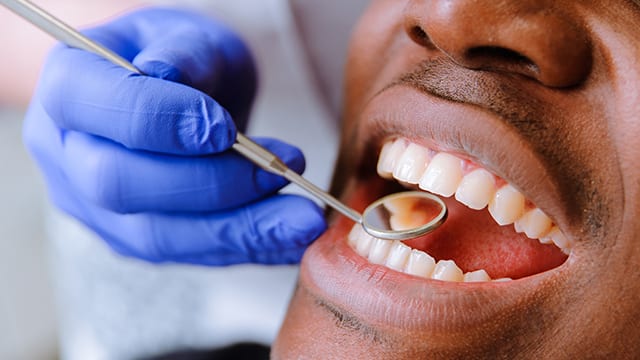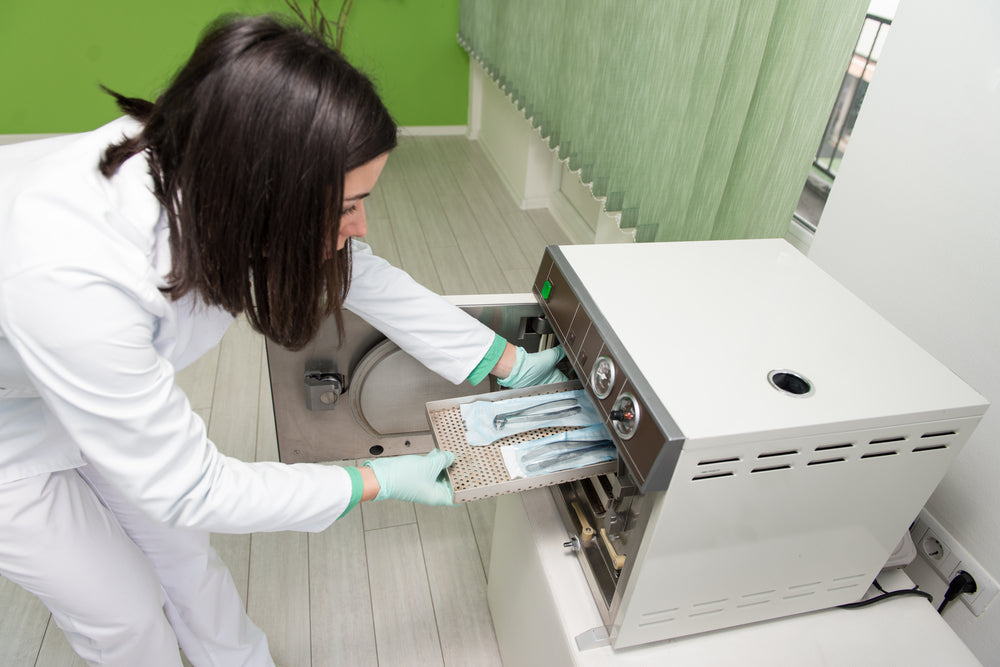Dentists clean their tools by soaking them in disinfectant solutions and using autoclaves for sterilization. This process ensures tools are free from harmful bacteria and ready for use on patients.
Maintaining proper hygiene in dental offices is essential for patient safety. Dentists follow strict protocols to clean and sterilize their tools to prevent the spread of infections. By using disinfectant solutions and autoclaves, they ensure that instruments are thoroughly sanitized.
Patients can feel confident in the cleanliness of their dentist’s tools, promoting trust and overall satisfaction with their dental care. Understanding the meticulous cleaning procedures dentists employ can help patients feel more at ease during their appointments. Preventing cross-contamination and maintaining a sterile environment is a top priority in dental practices worldwide.
Methods Of Cleaning Dental Tools
Keeping dental tools clean and sterilized is a crucial aspect of maintaining a safe and hygienic environment in a dental practice. Dentists employ various methods to ensure that their tools are free from harmful bacteria and ready for use on patients.
Manual cleaning is a primary step in the process of cleaning dental tools. It involves manually scrubbing the tools with a brush and antimicrobial soap, which helps to remove debris and biofilm.
After manual cleaning, the tools are rinsed thoroughly to remove any remaining residue. This method is effective in eliminating visible dirt and is often the initial step before proceeding to more advanced cleaning methods.
Ultrasonic cleaning is a method that utilizes high-frequency sound waves to create vibrations in a cleaning solution. This process helps to dislodge and remove debris, including microorganisms, from dental tools.
The tools are placed in a specialized ultrasonic cleaner filled with a cleaning solution. As the sound waves agitate the solution, it penetrates hard-to-reach areas of the tools, ensuring a thorough cleaning process.
Chemical disinfection involves immersing dental tools in a disinfecting solution to eliminate any remaining microorganisms. This step provides an additional layer of protection against infectious agents.
The disinfectant solution is carefully chosen to effectively kill bacteria and viruses without causing damage to the tools. After the disinfection process, the tools are rinsed and dried, ready for sterilization and subsequent use.

Credit: www.colgate.com
Manual Cleaning
Manual cleaning is a crucial step in maintaining the hygiene of dental tools. Let’s delve into the three main processes involved: Brushing, Rinsing, and Drying.
Brushing
Dentists use soft-bristled brushes to meticulously clean tools to ensure no residue is left.
Rinsing
Once brushed, the tools are rinsed thoroughly to remove any remaining debris or cleaning solution.
Drying
Finally, the cleaned instruments are carefully dried to prevent any moisture buildup that could lead to contamination.
Ultrasonic Cleaning
Ultrasonic Cleaning: Dentists rely on ultrasonic cleaning to ensure their tools are thoroughly sanitized and free from harmful bacteria.
Principle Of Ultrasonic Cleaning
Ultrasonic cleaning utilizes high-frequency sound waves to create millions of microscopic bubbles that implode on the surface of instruments, effectively removing debris and bacteria.
Procedure
Tools are placed in a specialized machine filled with a cleaning solution. The ultrasonic vibrations dislodge stubborn particles, ensuring a deep clean.
Advantages
Ultrasonic cleaning is highly efficient, reducing the risk of cross-contamination and ensuring tools are sterilized effectively.
Credit: www.stephenscitydental.com
Chemical Disinfection
Chemical disinfection is a crucial part of maintaining a sterile environment in dental practices. Dentists use various types of disinfectants to clean their tools, ensuring the safety and health of their patients. Understanding the different types of disinfectants, their application, and effectiveness is essential in comprehending the meticulous process of tool sanitation in dentistry.
Types Of Disinfectants
Dentists utilize several types of disinfectants, each with its unique properties to effectively kill germs and prevent the spread of infections. These include:
- Bleach-based disinfectants: Effective against a broad spectrum of microorganisms and commonly used for surface disinfection in dental offices.
- Alcohol-based disinfectants: These disinfectants are used to wipe down instruments and surfaces, offering rapid germ-killing action.
- Quaternary Ammonium Compounds: These disinfectants are long-acting and particularly effective against viruses and fungi.
Application
After cleaning the tools, dentists apply the selected disinfectant according to the manufacturers’ instructions. They ensure that the disinfectant covers all surfaces and remains in contact for the specified contact time to effectively kill any remaining microorganisms.
Effectiveness
The effectiveness of chemical disinfection depends on various factors such as the type of disinfectant used, correct application, concentration, and contact time. Dentists meticulously adhere to the recommended protocols to ensure the complete elimination of pathogens from their tools, maintaining a safe and sterile environment for their patients.
Importance Of Proper Tool Cleaning
Proper tool cleaning is of utmost importance when it comes to maintaining a sterile and safe environment in a dental clinic. Dentists understand that cleaning their tools thoroughly not only prevents cross-contamination but also ensures the safety of their patients. In this article, we will delve into the importance of proper tool cleaning and how it plays a crucial role in preventing the spread of infections and diseases.
Prevention Of Cross-contamination
Cross-contamination is a significant concern in any healthcare setting, and dental clinics are no exception. The tools used during dental procedures can come into contact with blood, saliva, and other bodily fluids, which may contain harmful pathogens. If these tools are not properly cleaned and sterilized, they can easily transmit these pathogens from one patient to another, putting everyone at risk.
To prevent cross-contamination, dentists follow strict cleaning protocols that involve the proper cleaning, disinfection, and sterilization of their tools. Cleaning these tools removes any visible debris, while disinfection and sterilization processes eliminate any remaining microorganisms, ensuring that the tools are safe for use on the next patient.
Maintenance Of Sterilization
Sterilization is a critical step in the process of cleaning dental tools. It involves the complete eradication of all microorganisms, including bacteria, viruses, and fungi, from the surfaces of the instruments. Sterilization is necessary to ensure that the tools do not act as a source of infection when they are used on patients.
Dentists employ various methods for sterilizing their tools, such as autoclaving, chemical sterilization, and dry heat sterilization. These methods are carefully chosen based on the type of instrument and its material to achieve optimal sterilization. Regular maintenance of sterilization equipment is also essential to ensure its effectiveness and reliability.
Enhancing Patient Safety
The primary goal of proper tool cleaning is to enhance patient safety. Dental procedures can involve invasive techniques that create open wounds or expose soft tissues to potential contaminants. By cleaning their tools appropriately, dentists decrease the risk of infections and complications arising from these procedures.
A clean and sterile environment not only ensures the safety of patients but also promotes their peace of mind. When patients see their dentist using clean and sterilized instruments, they gain confidence in the quality of care they receive, allowing them to relax during their dental visits.

Credit: www.mesaustralia.com.au
Frequently Asked Questions Of How Do Dentists Clean Their Tools
What Do Dentists Use To Clean Tools?
Dentists use an autoclave, a high-pressure steam sterilization machine, to clean their tools. The process eliminates bacteria, viruses, and other microorganisms to ensure a safe and hygienic environment for dental procedures.
How Do You Clean Dental Instruments?
To clean dental instruments, use an enzymatic cleaner and ultrasonic bath. Scrub with a brush, sterilize, and then package for autoclaving.
How Do You Remove Plaque From A Dental Tool?
To remove plaque from a dental tool, soak it in a mixture of equal parts water and vinegar. Scrub with a brush and rinse thoroughly.
Do Dentists Use New Tools Every Time?
Yes, dentists use new tools for each procedure to ensure patient safety and effective treatment.
Conclusion
Understanding how dentists clean their tools is essential for ensuring patient safety and overall effectiveness of dental treatments. By adhering to strict sterilization protocols and using advanced cleaning techniques, dentists can maintain a hygienic environment. Patients can feel confident in the cleanliness of the dental tools used during their treatments.
